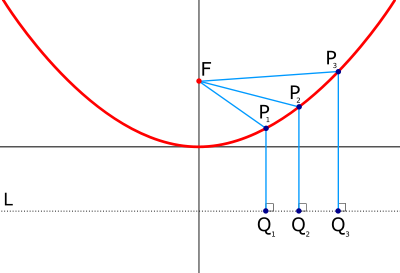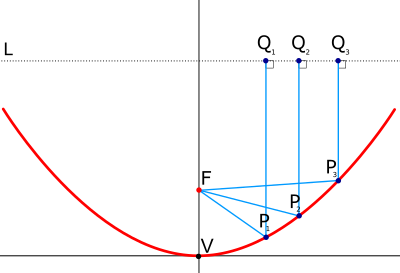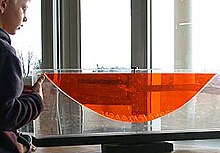Parabola


In mathematics, the parabola (Template:PronEng, from the Greek παραβολή) is a conic section, the intersection of a right circular conical surface and a plane parallel to a generating straight line of that surface. Given a point (the focus) and a line (the directrix) that lie in a plane, the locus of points in that plane that are equidistant to them is a parabola.
A particular case arises when the plane is tangent to the conical surface of a circle. In this case, the intersection is a degenerate parabola consisting of a straight line.
The parabola is an important concept in abstract mathematics, but it is also seen with considerable frequency in the physical world, and there are many practical applications for the construct in engineering, physics, and other domains.
History
The earliest known work on conic sections was by Menaechmus in the fourth century B.C.. He discovered a way to solve the problem of doubling the cube using parabolas. (The solution, however, does not meet the requirements imposed by compass and straightedge construction.) The name "parabola" is due to Apollonius, who discovered many properties of conic sections. The focus–directrix property of the parabola and other conics is due to Pappus.
Galileo showed that the path of a projectile follows a parabola, a consequence of uniform acceleration due to gravity.
The idea of using a paraboloid in a reflecting telescope is due to James Gregory in 1663 and the first to be constructed was by Isaac Newton in 1668. The same principle is used in satellite dishes and radar receivers.
Analytic Geometry Equations


In Cartesian coordinates, a parabola with an axis parallel to the axis with vertex , focus , and directrix , with being the distance from the vertex to the focus, has the equation with axis parallel to the -axis
or, alternatively with axis parallel to the x-axis
More generally, a parabola is a curve in the Cartesian plane defined by an irreducible equation of the form
such that , where all of the coefficients are real, where or , and where more than one solution, defining a pair of points (x, y) on the parabola, exists. That the equation is irreducible means it does not factor as a product of two not necessarily distinct linear equations.
Other geometric definitions
A parabola may also be characterized as a conic section with an eccentricity of 1. As a consequence of this, all parabolas are similar. A parabola can also be obtained as the limit of a sequence of ellipses where one focus is kept fixed as the other is allowed to move arbitrarily far away in one direction. In this sense, a parabola may be considered an ellipse that has one focus at infinity. The parabola is an inverse transform of a cardioid.
A parabola has a single axis of reflective symmetry, which passes through its focus and is perpendicular to its directrix. The point of intersection of this axis and the parabola is called the vertex. A parabola spun about this axis in three dimensions traces out a shape known as a paraboloid of revolution.
The parabola is found in numerous situations in the physical world (see below).
Equations
(with vertex (h, k) and distance p between vertex and focus - note that if the vertex is below the focus, or equivalently above the directrix, p is positive, otherwise p is negative; similarly with horizontal axis of symmetry p is positive if vertex is to the left of the focus, or equivalently to the right of the directrix)
Cartesian
Vertical axis of symmetry
-
- .
Horizontal axis of symmetry
-
- .
General parabola
The general form for a parabola is
This result is derived from the general conic equation ) and the fact that, for a parabola, .
Latus rectum, semi-latus rectum, and polar coordinates
In polar coordinates, a parabola with the focus at the origin and the directrix parallel to the y-axis, is given by the equation
where l is the semilatus rectum: the distance from the focus to the parabola itself, measured along a line perpendicular to the axis. Note that this is twice the distance from the focus to the apex of the parabola or the perpendicular distance from the focus to the latus rectum.
The latus rectum is the chord that passes through the focus and is perpendicular to the axis. It has a length of 4l.
Gauss-mapped form
A Gauss-mapped form: has normal .
Derivation of the focus


To derive the focus of a simple parabola, where the axis of symmetry is parallel to the y-axis with the vertex at (0,0), such as
then there is a point (0,f) — the focus, F — such that any point P on the parabola will be equidistant from both the focus and the linea directrix, L. The linea directrix is a line perpendicular to the axis of symmetry of the parabola (in this case parallel to the x axis) and passes through the point (0,-f). So any point P=(x,y) on the parabola will be equidistant both to (0,f) and (x,-f).
FP, a line from the focus to a point on the parabola, has the same length as QP, a line drawn from that point on the parabola perpendicular to the linea directrix, intersecting at point Q.
Imagine a right triangle with two legs, x and f-y (the vertical distance between F and P). The length of the hypotenuse, FP, is given by
(Note that (f-y) and (y-f) produce the same result because it is squared.)
The line QP is given by adding y (the vertical distance between the point P and the x-axis) and f (the vertical distance between the x-axis and the linea directrix).
These two line segments are equal, and, as indicated above, y=ax², thus
Square both sides,
Cancel out terms from both sides,
Divide out the x² from both sides (we assume that x is not zero),
So, for a parabola such as f(x)=x², the a coefficient is 1, so the focus F is (0,¼)
As stated above, this is the derivation of the focus for a simple parabola, one centered at the origin and with symmetry around the y-axis. For any generalized parabola, with its equation given in the standard form
- ,
the focus is located at the point
which may also be written as
and the directrix is designated by the equation
which may also be written as
Reflective property of the tangent
The tangent of the parabola described by equation (1) has slope
This line intersects the y-axis at the point (0,-y) = (0, - a x²), and the x-axis at the point (x/2,0). Let this point be called G. Point G is also the midpoint of points F and Q:
Since G is the midpoint of line FQ, this means that
and it is already known that P is equidistant from both F and Q:
and, thirdly, line GP is equal to itself, therefore:
It follows that .
Line QP can be extended beyond P to some point T, and line GP can be extended beyond P to some point R. Then and are vertical, so they are equal (congruent). But is equal to . Therefore is equal to .
The line RG is tangent to the parabola at P, so any light beam bouncing off point P will behave as if line RG were a mirror and it were bouncing off that mirror.
Let a light beam travel down the vertical line TP and bounce off from P. The beam's angle of inclination from the mirror is , so when it bounces off, its angle of inclination must be equal to . But has been shown to be equal to . Therefore the beam bounces off along the line FP: directly towards the focus.
Conclusion: Any light beam moving vertically downwards in the concavity of the parabola (parallel to the axis of symmetry) will bounce off the parabola moving directly towards the focus. (See parabolic reflector.)
The same reasoning can be applied to a parabola whose axis is vertical, so that it can be specified by the equation
- .
The tangent has then a generic slope of
- .
Reflection derivation, together with trigonometric angle addition rules, leads to the result that the reflected ray has a slope of
- .
When b varies
Vertex of a parabola: Finding the y-coordinate
We know the x-coordinate at the vertex is , so substitute it into the equation
Simplifying:
Thus, the vertex is at point
Parabolas in the physical world

In nature, approximations of parabolas and paraboloids are found in many diverse situations. The most well-known instance of the parabola in the history of physics is the trajectory of a particle or body in motion under the influence of a uniform gravitational field without air resistance (for instance, a baseball flying through the air, neglecting air friction). The parabolic trajectory of projectiles was discovered experimentally by Galileo in the early 17th century, who performed experiments with balls rolling on inclined planes. He also later proved this mathematically in his book 'Dialogue Concerning Two New Sciences'[1].[2] For objects extended in space, such as a diver jumping from a diving board, the object itself follows a complex motion as it rotates, but the center of mass of the object nevertheless forms a parabola. As in all cases in the physical world, the trajectory is always an approximation of a parabola. The presence of air resistance, for example, always distorts the shape, although at low speeds, the shape is a good approximation of a parabola. At higher speeds, such as in ballistics, the shape is highly distorted and does not resemble a parabola.

Another situation in which parabola may arise in nature is in two-body orbits, for example, of a small planetoid or other object under the influence of the gravitation of the sun. Such parabolic orbits are a special case that are rarely found in nature. Orbits that form a hyperbola or an ellipse are much more common. In fact, the parabolic orbit is the borderline case between those two types of orbit. An object following a parabolic orbit moves at the exact escape velocity of the object it is orbiting, while elliptical orbits are slower and hyperbolic orbits are faster.
Approximations of parabolas are also found in the shape of the main cables on a typical suspension bridge. Freely hanging cables as seen on a simple suspension bridge do not describe parabolic curves, but rather hyperbolic catenary curves. Under the influence of a uniform load (such as a horizontal suspended deck), the otherwise hyperbolic cable is deformed toward a parabola. Unlike an inelastic chain, a freely-hanging spring of zero rest length takes the shape of a parabola.
Paraboloids arise in several physical situations as well. The most well-known instance is the parabolic reflector, which is a mirror or similar reflective device that concentrates light or other forms of electromagnetic radiation to a common focal point. The principle of the parabolic reflector may have been discovered in the 3rd century BC by the geometer Archimedes, who, according to a legend of debatable veracity,[3] constructed parabolic mirrors to defend Syracuse against the Roman fleet, by concentrating the sun's rays to set fire to the decks of the Roman ships. The principle was applied to telescopes in the 17th century. Today, paraboloid reflectors can be commonly observed throughout much of the world in microwave and satellite dish antennas.
Paraboloids are also observed in the surface of a liquid confined to a container and rotated around the central axis. In this case, the centrifugal force causes the liquid to climb the walls of the container, forming a parabolic surface. This is the principle behind the liquid mirror telescope.
Aircraft used to create a weightless state for purposes of experimentation, such as NASA's “Vomit Comet,” follow a vertically parabolic trajectory for brief periods in order to trace the course of an object in free fall, which produces the same effect as zero gravity for most purposes.
See also
- Catenary
- Conic section
- Ellipse
- Hyperbola
- Parabolic constant
- Parabolic reflector
- Parabolic partial differential equation
- Paraboloid
- Quadratic equation
- Quadratic function
Notes
- ^ Dialogue Concerning Two New Sciences (1638) (The Motion of Projectiles: Theorem 1); see [http:oll.libertyfund.org]
- ^ However, this parabolic shape, as Newton recognized, is only an approximation of the actual elliptical shape of the trajectory, and is obtained by assuming that the gravitational force is constant (not pointing toward the center of the earth) in the area of interest. Often, this difference is negligible, and leads to a simpler formula for tracking motion.
- ^ Middleton, W. E. Knowles (1961). "Archimedes, Kircher, Buffon, and the Burning-Mirrors" (GIF). Isis. 52 (4): 533–543. doi:10.1086/349498. Retrieved 2006-08-08.
{{cite journal}}: Unknown parameter|month=ignored (help)
References
- Lockwood, E. H. (1961): A Book of Curves, Cambridge University Press
External links
- Weisstein, Eric W. "Parabola". MathWorld.
- Interactive parabola-drag focus, see axis of symmetry, directrix, standard and vertex forms
- Archimedes Triangle and Squaring of Parabola at cut-the-knot
- Two Tangents to Parabola at cut-the-knot
- Parabola As Envelope of Straight Lines at cut-the-knot
- Parabolic Mirror at cut-the-knot
- Three Parabola Tangents at cut-the-knot
- Module for the Tangent Parabola
- Focal Properties of Parabola at cut-the-knot
- Parabola As Envelope II at cut-the-knot
- The similarity of parabola at Dynamic Geometry Sketches
































































